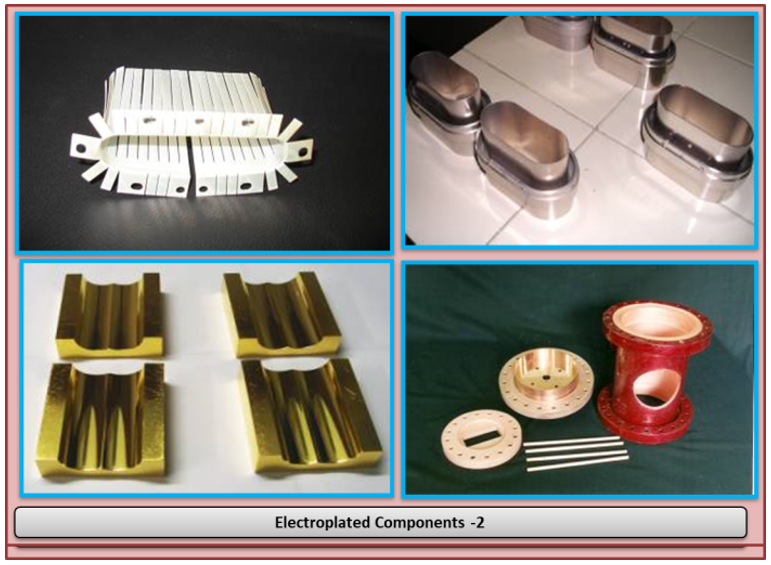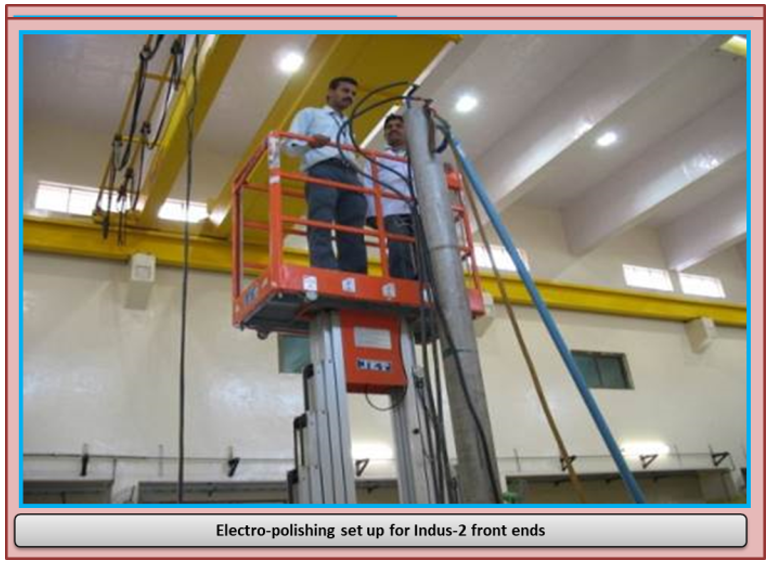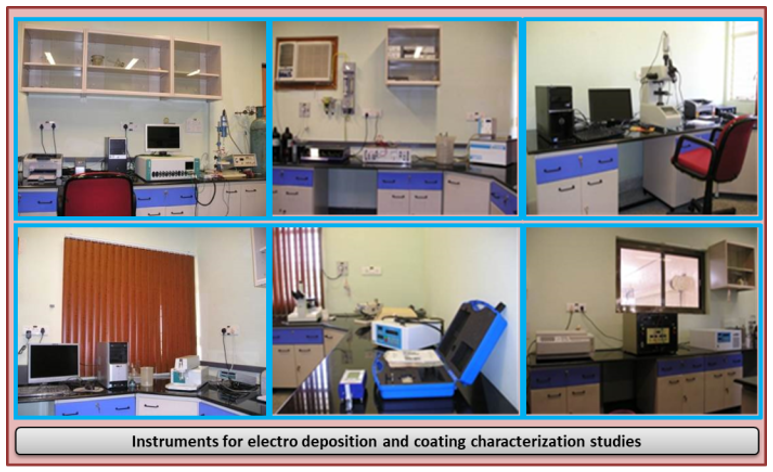|
This facility has all the basic equipments and infrastructure required for cleaning and surface modification of components used in lasers and accelerators. Various processes being carried out in this facility likeelectrodeposition, electro polishing, anodizing and chemical treatment are well supported by an analytical and coating characterization lab having modern instruments. Special development works are also undertaken in the areas of electroforming and nanowire fabrication.
Team Members –
Dr. P Ram Sankar, SO/G, Head, Chemical Treatment Facility Lab
The team consists of 12 members including Engineers and skilled technicians.
History: Chemical Treatment Facility was established initially for cleaning and electropolishing of ultra high vacuum components used in accelerators and lasers. Activities were later extended in the areas of electrodeposition, anodization and conversion coatings to meet specific functional requirements of various laboratories of RRCAT. Analytical and electrochemistry labs having various instruments like UV-Visible Spectrophotometer, FTIR, AAS, Galvanostat, microhardness tester, thickness testers etc., were also established for process control and analysis of treated and untreated effluents. Development activities in the field of electroforming and nanowire fabrication are also under progress. Presently work is nearing completion for zero discharge waste treatment system.
Facilities: The laboratory has all the basic and advanced equipments such as pulsed power supplies, rectifiers of varying capacities, water purifications systems, compressors, high pressure washers, heating andcooling systems required for surface preparation and modification of components used in accelerators and lasers. This facility is well supported by analytical, electro chemistry and coating characterization labs for process and quality control with modern instruments. Effluent treatment plant is also available for the treatment of used electrolytes and waste water generated during various processes.
- Surface preparation
- Surface modification
- Analytical Lab
- Electro chemistry lab
- Coating Characterization lab
Surface Preparation: Surface preparation is a pre-requisite process before any surface modification treatments like elecropolishing, anodizing and electroplating. This is also essential for vacuum components to attain high vaccum. Buffered chemical polishing of niobium half cells and end components is an essential step before electron beam welding of the parts.
- Ultrasonic cleaning & Vapor degreasing
- Chemical Treatment
- Buffered Chemical Polishing
Ultrasonic cleaning & Vapor degreasing: The lab has facilities to clean components using ultrasonic and vapor degreasing sytems. Cleaning systems of different dimensions are available to accommodate components ranging from millimeter to meters. Oil, grease and dust particles that are adhered to the surface during various fabrication processes will be removed.
Chemical Treatment: Chemical cleaning of mild steel, stainless steel, aluminum, brass, copper and niobium are being carried out regularly.
Surface Modification:Surface modification techniques available in this facility include electrodeposition of different metals, electropolishing of stainless steel, and anodic oxidation of aluminium, pre-weld etching of niobium half cells and establishment of electroforming facility for different type of micro and macro components are being under progress.
- Electrodeposition
- Electropolishing
- Electroforming
- Anodic oxidation
Electrodeposition:Electrodeposition is required for meeting specific functional requirements such as conductivity, brazing of stainless steel to copper, reflectivity, corrosion and wear resistance. Copper plating is carried out on various accelerator components for providing conductivity and joining of stainless to copper by vacuum brazing. RF cavities of Indus-1, PWT linac components, RFQ chambers, DTL tanks were some of the important components deposited with copper to meet functional requirements. Nickel deposition is used as a base coating for laser reflectors made of copper and brass before gold deposition. This barrier coating prevents diffusion of gold into the substrate in addition to corrosion resistance. : Electroless Nickel is an engineering coating that is deposited without passage of current. Electroless coating is required for corrosion resistance, high hardness and wear resistance. This is also applied for lubricity and brazing applications. Rhodium plating is required on stainless steel stubs for wear resistance and to decrease contact resistance. Silver plating is needed for good electrical conductance and lubricity. Some of the silver plated components are wave guides, bus bars, beryllium copper fingers, nutsand bolts for vacuum chambers. Gold plating is needed for laser mirrors, reflectors, electrodes, sensors of thermostats and printed circuit boards for various functional requirements like reflectivity, corrosion resistance and low contact resistance.


Electropolishing:Electropolishing of ultra high vacuum components is done for reducing effective surface area to minimize outgassing. In this process material is removed from the surface thereby reducing the surface contamination. Beam lines, front ends, sputter ion pumps, honey combs, beam position monitor chambers and other vacuum components are regularly processed.
Anodic Oxidation:Anodizing is the process of converting aluminum to aluminum oxide in acid electrolytes. The component to be anodized is made anode and lead is used as cathode. During process oxygen is liberated at the anode which forms aluminum oxide on the components. Anodization is done on components where electrical insulation, hardness, wear and abrasion resistance are required. Aluminum oxide film can adsorb organic dyes and can be sealed. This method is also used for blackening of optical components.
Electroforming:Electroforming is the process of electrodepositing a metal on a mandrel, which when separated from the mandrel produce an independent, freestanding object. This is a valuable technique for fabricating parts that cannot be produced by other manufacturing methods and can offer an economic alternative to other manufacturing methods. Presently work is under progress for fabricating micro and macro structures and its characterization for functional requirements.
Analytical Chemistry Lab:The laboratory is well equipped with all basic and advanced analytical instruments required for the analysis of electrolytes, solutions, solvents and effluents. Although it is a dedicated facility to CTF, samples received from other sections are also being analysed. The analytical lab has instrumental and wet analysis facilities.
- Instrumental analysis
- Wet analysis
Instrumental analysis:Instrumental analysis is being carried out using multi parameter meter, UV-Visible Spectrophotometer, FTIR spectrophotometer, Atomic Absorption Spectrophotometer etc., for process control and effluent analysis.
Wet analysis:Analysis of raw water, de-ionized water and effluent for metallic and non metallic impurities along with analysis of chemical cleaning, electroplating, anodizing and electro polishing solutions for process control have been carried out in this facility.
Electro chemistry Lab:This laboratory is well equipped with various equipments and instruments required for electrodeposition studies. Electrochemical synthesis of metallic nanowires inside porous
aluminum oxide template was initiated to make velvet targets for ultra Pico second lasers. Velvet targets of nickel and copper were fabricated. Cadmium selenide nanostructures were also fabricated and characterized.
Coating Characterization Lab: This laboratory has facility to determine micro hardness, thickness, adhesion and gloss of various deposits and modified surfaces. Capacitance, impedance measurements, corrosion and voltammetry studies are being carried out using different types of electrochemical instruments.

Effluent Treatment:Electroplating waste is highly complex in nature as it contains many metallic as well as nonmetallic ions. These ions are having marked effect on human beings and ecosystem. Hence, proper treatment of plating waste is essential and quite a challenge in any of the electrodepostion labs. Waste water generated from various processes of this facility is collected in the storage tanks. After lime treatment in a neutralization tank, it is passed through RO plant to get treated waste free from toxic ions as per the guidelines laid down by ASTM and IS. It is then analyzed and disposed to the ecosystem. Recently, an ion exchange plant has been erected and integrated with the existing treatment plant for reuse of waste water after treatment.
|









 Design & Manufacturing Technology Division
Design & Manufacturing Technology Division




